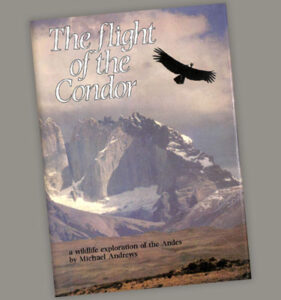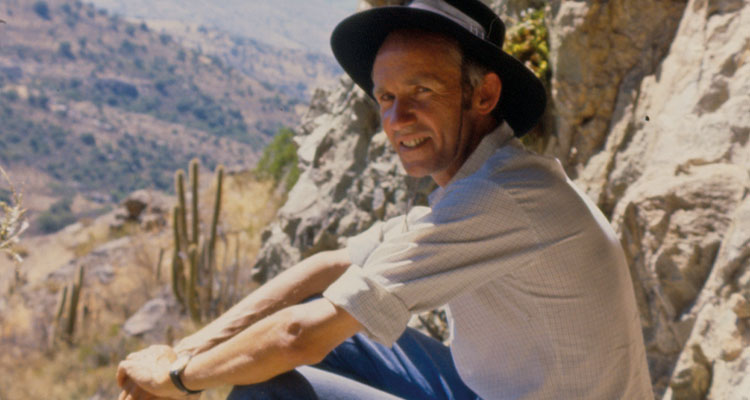Mike Andrews (Chatham 57) writes of the night a vampire bat went for his ankles.
I was camping with my small film crew from the BBC Natural History Unit in the shell of a concrete building at Punta San Juan, enveloped in the sour smell of a colony of millions of Guanay cormorants. Known as the ‘billion-dollar bird’, their guano (Quechua for excrement, a potent fertiliser) had built a fortune for the Gibbs family and a Victorian gothic mansion Tyntesfield, only 15 miles from where I sit now. We were there to film for my series The Flight of the Condor in 1980, and we wanted to capture the behaviour of the extraordinary fauna of the Atacama Desert in Peru. There were about a dozen of us eating supper sitting either side of a long table on wooden benches. Suddenly, caught in my peripheral vision, I spotted a black creature scuttling fast towards us on its feet and elbows, nostrils flared and fangs bared. It was like a vision from Hieronymus Bosch. I yelped a warning and I have never seen people scatter from a table so fast. I then had to catch the bat.
It had all begun in 1960, when I had helped drive a Land Rover from Tierra del Fuego to Alaska (see The Corinthian 6). I had fallen in love with the Andes with its spectacular scenery and wildlife, and now, twenty years older, I had the skills and the finance to do it justice on film. The best sequences of wildlife behaviour are frequently filmed with the help of zoologists, but this time we had a vet. Dr Aurelio Malaga Alba was a frail seventy-nine, but he had studied vampire bats at the University of San Marcos in Lima – as a vector and probable reservoir of the rabies virus – decades before. He was longing for us to prove his hypothesis.
 Few mammals are more detested than a vampire bat. Desmodus rotundus lives along the length of South America from Trinidad to Patagonia, and it feeds exclusively on blood. We had noted white flags flying above the corrals of peasant farmers – supposedly to frighten them away from their animals. Our scientific advisor, Lucho Peña had spent three weeks scouring the caves along the desert coast, but the bats had always been driven away by the fishermen who camped there, catching shellfish and at times mincing sealions into illicit sausages. The bats were becoming an endangered species. Dr Malaga was convinced that historically and unmolested, the bats must have been feeding on the sealions at night because they were by far the most abundant source of blood along the edge of a lifeless desert. I did not think we had a hope of filming this unreported behaviour in the wild and the only alternative was to film it on a confined ‘set’.
Few mammals are more detested than a vampire bat. Desmodus rotundus lives along the length of South America from Trinidad to Patagonia, and it feeds exclusively on blood. We had noted white flags flying above the corrals of peasant farmers – supposedly to frighten them away from their animals. Our scientific advisor, Lucho Peña had spent three weeks scouring the caves along the desert coast, but the bats had always been driven away by the fishermen who camped there, catching shellfish and at times mincing sealions into illicit sausages. The bats were becoming an endangered species. Dr Malaga was convinced that historically and unmolested, the bats must have been feeding on the sealions at night because they were by far the most abundant source of blood along the edge of a lifeless desert. I did not think we had a hope of filming this unreported behaviour in the wild and the only alternative was to film it on a confined ‘set’.
Dr Malaga had spent six years studying in Edinburgh and he had three passions: Christmas pudding, kippers and vampires. I had brought him a Christmas pudding but the kippers had not survived our drive for days across the oven-like desert. He checked into the smart Las Dunas Hotel in Ica and asked the kitchen staff to put a large red jar in their fridge.
“What is it?”
“Blood.” They thought this a huge joke, but they took the jar.
“What’s it for?”
“To feed the vampires, of course.” This doubled them up with laughter.
Meanwhile, 13 vampire bats were dangling from the shower-rail of his en-suite bathroom with a saucer of defibrinated blood below. Dr Malaga had caught them in a haunt he knew well, hanging high in the entrance archway of the Inca Citadel of Pachacamac – beneath which dozens of tourists passed every day.
Dr Malaga never kept his vampires caged at night, even if they had to fly loose in his bedroom while he and his wife Mary slept beneath mosquito-nets (with no big-toes exposed). Mary was amazingly tolerant of her husband’s macabre but epidemiologically significant enthusiasm. By the morning, the bathroom looked like the set of Psycho with blood splattered all over the walls. Mary had to clean it up before the housekeeper came in and fainted at the sight.
A dis-used concrete bedroom would do for the set. So, the next thing was to acquire a sealion. There were plenty of them – hundreds hauled out beneath the cliffs surrounding the bird colony. The males were massive beasts with furry manes and huge teeth. Amongst our small party, somebody would have to catch one and that, I realised with dismay, was me. I had grown up stalking rabbits for the pot and had some knowledge of field-craft, but this was a challenge on a different scale. The next morning, I crept along the foot of the cliff. There was a mother sealion with her large pup on top of a high slab of rock, up which I could climb. I made a sudden dash and grabbed and pinned the pup to the rock like scoring a try, making sure I kept well clear of those teeth. Pandemonium erupted on the beach with all the animals lolloping noisily into the sea. Donaldo MacIvor, my trusty sound recordist and general assistant, ran up with a sack and we had our quarry.
Then followed another bizarre scene as all of us shouldered rucksacks, carrying large round stones from the beach a hundred feet up concrete steps to that bedroom to ‘dress’ the floor to resemble the beach – complete with scraps of driftwood and seaweed. It was exhausting. At last, it was ready. We then sat down to our well-earned supper when that bat escaped from its cage and went for our ankles. Meanwhile our sealion went to sleep, apparently feeling very much at home on the ‘beach’.
Martin Saunders, my highly experienced cameraman, set up his lighting as ‘day-for-night’ and when all was ready, we released two of the vampires. One made straight for the largest area of the sealion not covered with fur – its nose, the other for a paw-like naked flipper. Vampire bats have a local anesthetic and an anti-coagulant in their saliva so after a quick bite and a brief check that their prey was not about to riposte, the vampires were soon lapping the blood that flowed from the cuts made by their razor teeth. The sealion pup slept on. We had our sequence in the can and Dr Malaga was overjoyed. His wife told me it completely rejuvenated him.
The next morning, we took the pup back to the sea and its mother. But I still needed shots of the bats in a cave. I had brought chicken-wire and we shut off the mouth of a small cave. Soon the vampires had obligingly hung themselves upside down from the roof. The only casualty was Martin, who had gotten bitten on the hand. Luckily, I had insisted that all our crew had an anti-rabies jab so it was no more than a nasty cut.
Decades later, I was discussing filming at the New York Zoological Society and I heard a disparaging report that the BBC had released vampire bats at the guano reserve. The foreman there had made a mistake. All ‘our’ bats were released back to their Inca lodging. So, if there are Vampire bats at Punta San Juan today, it is good news for the species.
 The Flight of the Condor later won nominations for a BAFTA award in five categories.
The Flight of the Condor later won nominations for a BAFTA award in five categories.
Copyright © Mike Andrews 2022.

